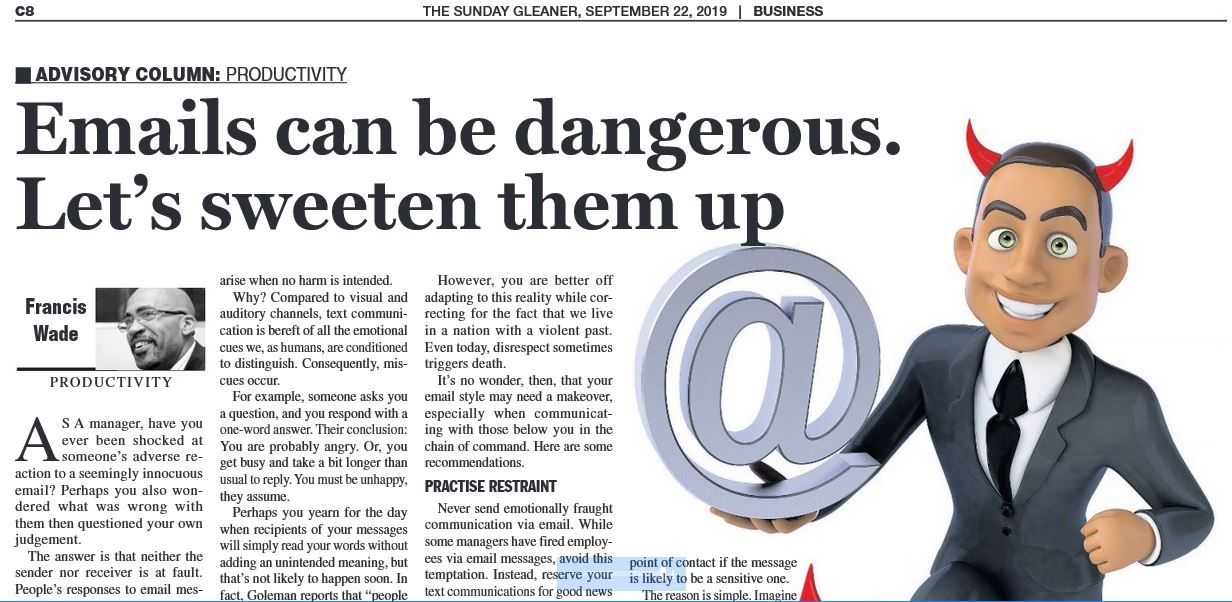As a manager, have you ever been shocked at someone’s adverse reaction to a seemingly innocuous email message? Perhaps you also wondered “What is wrong with him?”, then questioned your own judgement. The answer is that neither sender nor receiver is at fault. People’s response to email messages is unique, making this communication skill a must-have for leaders of all organizations.
Daniel Goldman, brain expert, confirms something you may already know: email can be dangerous. While it’s a necessary element of corporate life, problems often arise when no harm is intended.
Why? Compared to visual and auditory channels, text communication is bereft of all the emotional cues we, as humans, are conditioned to distinguish. Consequently, miscues occur.
For example, someone asks you a question and you respond with a one-word answer. Their conclusion? “You are probably angry.” Or, you get busy and take a bit longer than usual to reply. “You must be unhappy,” they assume.
Perhaps you yearn for the day when recipients of your messages will simply read your words without adding unintended meaning, but that’s not likely to happen soon. In fact, Goleman reports, “people interpret your positively intended email as neutral, and your neutrally intended email as negative.” Their survival instincts thwart your best intentions.
You may complain that this isn’t fair.
However, you are better off adapting to this reality, while correcting for the fact that we live in a nation with a violent past. Even today, disrespect sometimes triggers death.
It’s no wonder then, that your email style may need a makeover, especially when communicating with those below you in the chain of command. Here are some recommendations.
1. Never send emotionally fraught communication via email.
While some managers have fired employees via email messages, avoid this temptation. Instead, reserve your text communications for good news and sharing information. Don’t try to coach, give feedback, correct, counsel or apologize for anything critical.
If you must have a paper trail, write it out before the conversation and send it afterwards, as clarification. But never let it be the first point of contact if the message is likely to be a sensitive one.
The reason is simple. Imagine if your note is read an hour after the recipient receives news of someone’s passing. Obviously, if you were speaking to her in person, you would sense that the timing is bad and change gears. However, it’s easy to violate this accepted norm via text.
But what should you do to prevent a face-to-face conversation on a difficult matter from escalating into a shouting-match? Instead of looking for shortcuts, practice the challenging discussion with a colleague who can provide feedback in real time. This technique, often used by life coaches, should become a part of your regular training.
2. Never communicate in haste.
The worst moment to hit “Send” is when you are upset. A better alternative is to save the message in your drafts until you have calmed down and can reconsider your options. After a night’s sleep or a day’s work, things may look dramatically different and you want to be in your best, right mind when you make your final decision.
However, if you have difficulty knowing when you are upset (or in denial about ever being off-kilter) then try improving your Emotional Intelligence (EQ.) Doing so will benefit every aspect of your life.
3. Learn modern writing skills.
You may hate emojis. Ending a sentence with an “LOL” might be something you think you should never do. Perhaps in your world, “GIF” means nothing.
Even if you believe that these elements of modern communication “are not my style”, consider adding new skills. These seemingly silly add-ons are now part of the language most are using because they impart important, emotional context to dry textual content.
Here in Jamaica, for example, WhatsApp has long surpassed email as the most effective form of daily communication. One reason is due to its flexibility. A short message can be sent in multiple ways, via a range of media, enhanced by a variety of optional elements. The result is a faster, more precise method of sending brief messages that reduces the risk of misunderstanding.
But these fancy add-ons are not the point. Instead, the idea is to use every tool at your disposal to convey the emotional intent of your communication. Remember, Goleman tells us that recipients are likely to downgrade your message from positive to neutral and from neutral to negative. To be an effective leader, you must compensate for this tendency.
If you willfully refuse to sweeten up your messages, be warned: it’s only a matter of time before they bear bitter fruit. Don’t blame the recipient. Instead, improve your skills.

